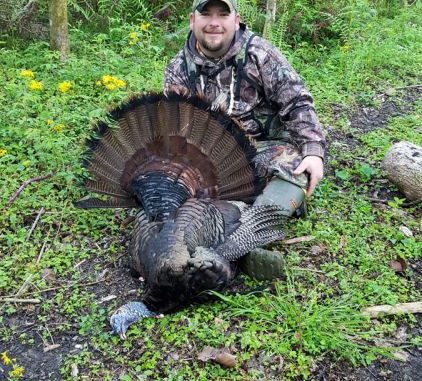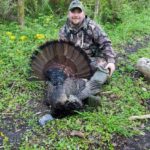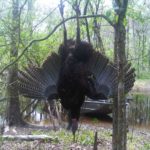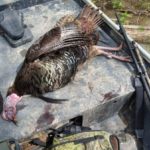
Accessing the turkey woods by boat offers a stealthy approach and an escape from the crowds — and is the perfect solution for tracking down Atchafalaya Basin gobblers.
The smoky haze billowing from the Atchafalaya River’s surface was the only motion on an otherwise still morning in early April.
No waves or rogue currents. No wind to nudge the trees and strands of Spanish moss from their branches.
Even the sun seemed to linger just barely above the horizon.
The pace of Jesse Langlois’ boat didn’t add any urgency to our morning. The tract of land to which we were heading to hunt turkeys was a hop across the river from Butte La Rose, where he lives.
As soon as the tip of the flat-bottom skiff skidded across the muddy bank of the river, Langlois handed me a spray bottle.
“Here, this’ll keep the gnats away,” he said.
My first thought was, “What’s in it?, followed by, “What gnats?”
Both questions were answered as I stepped off the boat and was instantly assaulted by bugs.
Langlois assured me his homemade concoction of vanilla extract, vinegar, water and who knows what else would ward off the pests.
I sprayed down quickly, but the Cajun’s brew couldn’t quell the gnats’ stubborn persistence.
Langlois took the lead up to higher ground, where he knew some gobblers had been a few days before.
Behind him was Chad Newcomer, the owner of Fat Lady Game Calls, who’d invited me on the hunt.
Newcomer and Langlois doubled on two swamp gobblers just the weekend before. Today was my day, they said.
I was convinced I’d be leaving with a tom.
After a few hundred yards, Langlois stopped in a food plot and let out an owl hoot. All I heard was buzzing, as mosquitos hovered near my face.
Langlois, with his trained ears and eyes still focused on the tract of woods ahead, paused. He let out another hoot.
This one yielded a faraway shriek.
After the gobbler sounded off again, it was clear to my more experienced hunting partners the bird was on the move.
“We need to cut him off,” Langlois said.
But by the time we circled to where the tom flew down, it got hung up. While I waited near the base of a tree, Langlois called and Newcomer scanned the woods.
More calling. More waiting.
Then, another shriek from a different direction.
“We can get to this one faster if we cut him off by boat,” Langlois whispered.
We gathered in the boat and floated south down the Atchafalaya, parked and stalked to where we had last heard the bird.
I again sat next to the base of a tree, with Newcomer to my right and Langlois to my left.
Two hunters with grand slams to their names by my side, calling and directing my every more. I felt it was only a matter of time before I packed a gobbler out of the swamp.
My grip on the borrowed 12-gauge tightened. My heart rate increased. I peeled my eyes and waited for the tom to step out from the green brush ahead, just like it was supposed to.
It never appeared.
“It doesn’t always go to plan,” Newcomer laughed on the boat ride back to the landing. “That’s a turkey for you.”
“Especially with these swamp turkeys,” Langlois chimed in. “Even if you cut them off with the boat, they’ll still find a way to beat you.”
Even though we got skunked that day, Langlois and Newcomer have had stellar results in the past while hunting with the help of a boat — and so have many other hunters, especially those in the Atchafalaya Basin.
“A lot of people hunt the Basin,” said Langlois, who has chased turkeys from New Mexico to Florida. “Those birds are so pressured and, with the water everywhere, a Basin turkey is the hardest I’ve hunted hands down.”
Langlois said his boat offers an escape from the crowds on public land. It’s the primary way he hunts Sherburne Wildlife Management Area and Indian Bayou.
It’s also a stealthy way to sneak up on turkeys.
Langlois often spends prolonged periods on the water until he knows exactly where a gobbler is before trekking into the woods.
“The best thing about using your boat is that you can troll up and down canals and never step foot in the woods,” he said. “When you’re walking and trying to located a bird, you can walk under the roost without knowing it and lose an opportunity. In the boat, you can locate a roost without them even knowing you’re there.
“Then, you sneak up with the trolling motor and ease up to the bank, get out and go to work.”
Learn the land
Langlois scouts three weeks before the season opens. He said turkeys prefer roosting in trees directly over or close to water, so he looks for sloughs or swampy areas as a starting point.
He covers as much ground as possible, while listening for gobbles and scanning for tracks or any other sign.
“Once you locate birds, you can fine tune them and home in on their location once the season starts,” Langlois said.
If he’s hunting a new area, particularly on public land, he initially does his recon via Google Earth. He looks for swampy areas he can access with a boat.
Then he puts boots on the ground to learn the area as best he can before the opener to equip him to deal with any curveballs a gobbler may present.
“You have to know the lay of the land,” Langlois said. “Knowing the terrain — where sloughs and roosts are — will help determine where you’ll set up if he goes in one direction versus another.
“If he gets hung up, if you know there’s a bayou in that direction, you can create a plan to get him.”
Newcomer also preps for the season by analyzing maps. He likes topographic maps so he can make notes of where all of the ridges and low ground are.
Once he’s found a few spots worth checking into, he gets into his boat and arrives at his presumptive location about an hour before sunset. He listens for gobbles until dark to pinpoint roosting locations.
“After dark, I’ll use a locater call of some kind to shock gobble the birds into giving away their location,” Newcomer said. “With the location of the bird known, you will have the upper hand on your approach.”
Approach slowly and quietly
Lafayette hunter David Simms doesn’t leave for the turkey woods without his boat, equipped with a trolling motor and a charged-up battery.
He didn’t always chase turkeys this way. Like many others, he trudged for miles through the woods.
“The first couple of years I hunted that way — parking (and) then walking through the woods a mile — I wasn’t hearing any birds,” Simms said. “But on mornings me and friends were fishing, using the trolling motor, we would hear them gobbling.
“So it became simple to me to start hunting them this way.”
He normally uses his outboard to get deep in the Atchafalaya Basin, where the only areas of high ground are ridges and spoil banks lining canals.
He said birds will roost on the edges of swamps and the canal banks.
“Accessing them through the woods is really not possible in many situations,” Simms explained. “It may be too far of a walk or if you have to make a loop around a bird it may not work.”
Once he’s within a mile from where he knows birds are roosting, he kills his outboard and trolls for a quiet approach.
As he closes the distance, he uses an owl hoot to get a tom to gobble.
This enables Simms to pinpoint exactly where the turkey is.
“You can troll up right to them since it’s so quiet,” he said. “Last year, we got within 80 yards of a bird off a canal. If you approach through the woods, you can bump deer and that makes all kinds of racket. It can take a while before the woods settle down after that.”
Simms said he typically likes to keep around 100 yards between him and a tom.
“I’ll creep up and set up on a ridge,” he said. “Normally they’ll pitch down onto dry land. But I have hunted turkeys in swamps that pitched down in 10 inches of water. They gobbled and walked in it. I would’ve never thought turkeys would do that.
“Any water deeper, though, and they’ll avoid it.”
If Simms suspects hens are in the area, he’ll stay even farther back.
In that situation, he’ll back out of the area and try to predict where the tom will be later in the morning, thus cutting it off.
He said that’s why it’s important to know the terrain, as well as having scouted beforehand to determine where birds frequent.
Langlois is more conservative in his approach.
He tries to park his boat a few hundred yards away after he hears a tom sound off or pitch down from a roost.
If the woods are thicker, he’ll push closer.
“When turkeys are in the trees, they are the most cautious because they’re looking out for predators before they fly down,” Langlois said. “I like to wait and listen until he lands. Once I know he’s on the ground and I got the idea of what direction he’s headed in, that’s when I make a move to get closer.”
Once out of the boat, Langlois said he’ll continue to listen for gobbles to determine the bird’s direction. He makes a loop to try to cut off the tom in the vicinity its traveling.
Once he’s confident he’s in front of where the tom will be, the hunter plans his ambush.
Seal the deal
Langlois’ public land setup doesn’t include a decoy, and he might even opt to go without one on private land, as well.
He said pressured birds become wary of decoys. So, normally, he quickly conceals himself and starts to call.
“I mostly use soft purrs or yelps — not anything aggressive,” Langlois said. “If you get aggressive with a highly pressured bird, he’ll shut up and won’t gobble.
“He may even go in the opposite direction.”
If the hunter doesn’t get an answer from a tom after a few low calls, Langlois will purr slightly louder in hopes of enticing the gobbler to close the distance or call back.
Once the gobbler does sound off, Langlois said he’ll stop calling and let the bird close the distance.
Simms said he typically uses a mouth or box call, though he prefers a slate to finish off a gobbler because he can produce quieter sounds.
Like Langlois, he calls sparingly when a gobbler closes the distance.
Simms said turkeys are always capable of delivering surprises, even if everything is done right during a hunt.
If he miscalculated where a bird was, though, it’s normally not enough to ruin a morning. Due to his stealthy mode of transportation, the error is easily fixed.
“I’ve had birds gobbling in a completely different direction than I thought,” Simms said. “I’m able to get back into the boat and sneak back up on them. If they are farther or I need to cut them off a different way, I just crank up the motor and go a mile, troll and pinpoint the bird again.
“It’s a no-brainer to hunt these birds this way.”



